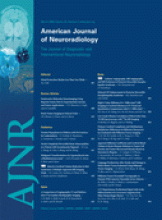Abstract
BACKGROUND AND PURPOSE: Previous studies have examined volumetric abnormalities in Rett syndrome (RTT), using MR imaging and focusing on selective changes. However, these studies preceded the identification of MECP2 as the gene mutated in most RTT cases. We studied regional brain volume changes as noted by MR imaging in girls with RTT who had mutations in the MECP2 gene and more or less severe clinical outcomes to further characterize the neuroanatomy of RTT and its correlations with clinical severity.
MATERIALS AND METHODS: Complementary semiautomated Talairach- and voxel-based approaches were used to study spoiled gradient-recalled acquisition sequence MR imaging scans from 23 girls with MECP2 mutations/RTT, including a pair of discordant monozygotic twins and 25 age-matched control girls. Both absolute and relative volumetric changes were examined to account for the well-documented global reduction in brain volume seen in RTT.
RESULTS: Absolute volumetric reductions were observed throughout the brain in RTT. Selective/relative decreases in parietal lobe gray matter, particularly in the dorsal parietal region, and mild, diffuse reductions in cortical white matter were observed in the RTT group compared with control subjects. In girls with RTT and a more severe phenotype, anterior frontal lobe volumes were relatively more reduced. Twin comparisons revealed selective preservation of the occipital cortex.
CONCLUSION: Selective reductions of dorsal parietal gray matter and preservation of the occipital cortex seem to be basic neuroanatomic features of RTT, whereas preferential reduction of the anterior frontal lobe appears to be a correlate of clinical severity in this disorder. The most affected brain regions include those that may underlie key functional deficits observed in RTT.
- Copyright © American Society of Neuroradiology












